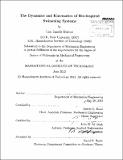| dc.contributor.advisor | Anette E. Hosoi and John W. M. Bush. | en_US |
| dc.contributor.author | Burton, Lisa Janelle | en_US |
| dc.contributor.other | Massachusetts Institute of Technology. Department of Mechanical Engineering. | en_US |
| dc.date.accessioned | 2013-10-24T17:44:41Z | |
| dc.date.available | 2013-10-24T17:44:41Z | |
| dc.date.copyright | 2013 | en_US |
| dc.date.issued | 2013 | en_US |
| dc.identifier.uri | http://hdl.handle.net/1721.1/81692 | |
| dc.description | Thesis (Ph. D.)--Massachusetts Institute of Technology, Dept. of Mechanical Engineering, 2013. | en_US |
| dc.description | Cataloged from PDF version of thesis. Page 168 blank. | en_US |
| dc.description | Includes bibliographical references (p. 155-167). | en_US |
| dc.description.abstract | The motion of biological systems in fluids is inherently complex, even for the simplest organisms. In this thesis, we develop methods of analyzing locomotion of both mechanical and biological systems with the aim of rationalizing biology and informing robotic design. We begin by building on existing visualization framework by studying an idealized swimmer: Purcell's three-link swimmer, at low Reynolds number. This framework allows us to illustrate the complete dynamics of the system, design gaits for motion planning and identify optimal gaits in terms of efficiency and speed. We extend the three-link swimmer case to include effects such as the interaction between the links. By studying several systems, we broaden the applicability of our framework. These systems include a two-link swimmer at low Reynolds number with offset centers of buoyancy and mass and a swimmer with a continuously deformable shape, the serpenoid swimmer. Drawing on the principles behind the serpenoid swimmer, we develop the kinematic decomposition, a method using a singular value decomposition (SVD) that describes the motion of complex systems in a low order manner. We show that with only two degrees of freedom, one can adequately describe an animal's motion. We apply this method to species in both high and low Reynolds number environments to elucidate different phenomena, including chemotaxing and species comparison in spermatozoa, gait changes in eels (steady versus accelerating), kinematic responses to viscosity and viscoelasticity in C. elegans (nematodes), and the Kirmin gait in trout. Combined with our visualization framework, we successfully illustrate the generalized utility of the kinematic decomposition method to explore and understand fundamental kinematics of a wide range of both natural and man-made systems. | en_US |
| dc.description.statementofresponsibility | by Lisa Janelle Burton. | en_US |
| dc.format.extent | 168 p. | en_US |
| dc.language.iso | eng | en_US |
| dc.publisher | Massachusetts Institute of Technology | en_US |
| dc.rights | M.I.T. theses are protected by
copyright. They may be viewed from this source for any purpose, but
reproduction or distribution in any format is prohibited without written
permission. See provided URL for inquiries about permission. | en_US |
| dc.rights.uri | http://dspace.mit.edu/handle/1721.1/7582 | en_US |
| dc.subject | Mechanical Engineering. | en_US |
| dc.title | The dynamics and kinematics of bio-in swimming systems | en_US |
| dc.type | Thesis | en_US |
| dc.description.degree | Ph.D. | en_US |
| dc.contributor.department | Massachusetts Institute of Technology. Department of Mechanical Engineering | |
| dc.identifier.oclc | 860899854 | en_US |
